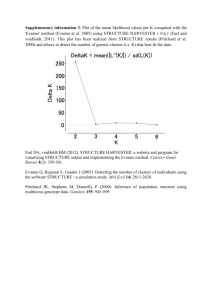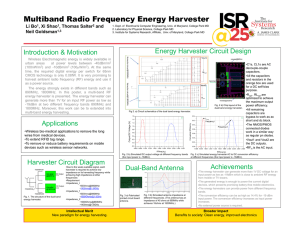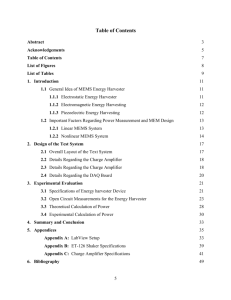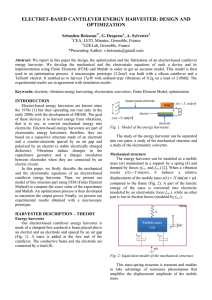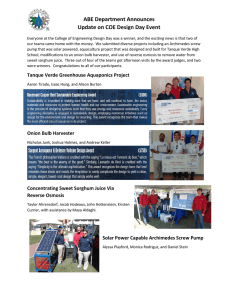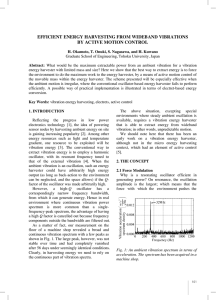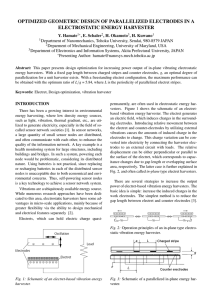3-D CAPACITIVE VIBRATIONAL HARVESTER FOR AUTONOMOUS LOW POWER SENSORS
advertisement
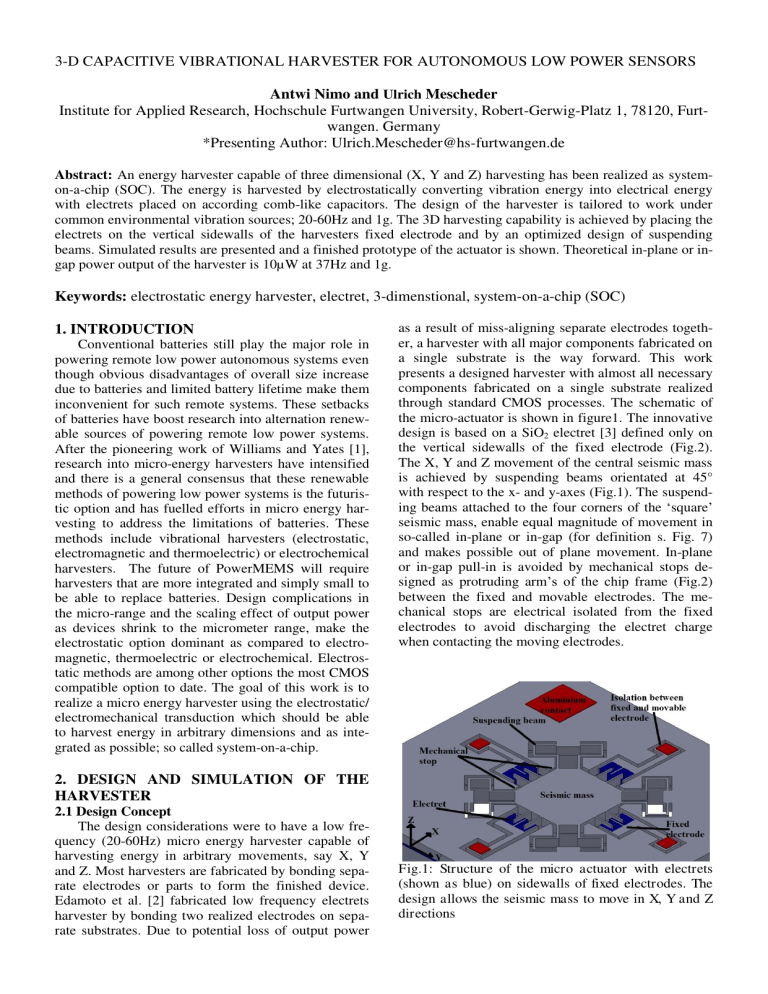
3-D CAPACITIVE VIBRATIONAL HARVESTER FOR AUTONOMOUS LOW POWER SENSORS Antwi Nimo and Ulrich Mescheder Institute for Applied Research, Hochschule Furtwangen University, Robert-Gerwig-Platz 1, 78120, Furtwangen. Germany *Presenting Author: Ulrich.Mescheder@hs-furtwangen.de Abstract: An energy harvester capable of three dimensional (X, Y and Z) harvesting has been realized as systemon-a-chip (SOC). The energy is harvested by electrostatically converting vibration energy into electrical energy with electrets placed on according comb-like capacitors. The design of the harvester is tailored to work under common environmental vibration sources; 20-60Hz and 1g. The 3D harvesting capability is achieved by placing the electrets on the vertical sidewalls of the harvesters fixed electrode and by an optimized design of suspending beams. Simulated results are presented and a finished prototype of the actuator is shown. Theoretical in-plane or ingap power output of the harvester is 10µW at 37Hz and 1g. Keywords: electrostatic energy harvester, electret, 3-dimenstional, system-on-a-chip (SOC) 1. INTRODUCTION Conventional batteries still play the major role in powering remote low power autonomous systems even though obvious disadvantages of overall size increase due to batteries and limited battery lifetime make them inconvenient for such remote systems. These setbacks of batteries have boost research into alternation renewable sources of powering remote low power systems. After the pioneering work of Williams and Yates [1], research into micro-energy harvesters have intensified and there is a general consensus that these renewable methods of powering low power systems is the futuristic option and has fuelled efforts in micro energy harvesting to address the limitations of batteries. These methods include vibrational harvesters (electrostatic, electromagnetic and thermoelectric) or electrochemical harvesters. The future of PowerMEMS will require harvesters that are more integrated and simply small to be able to replace batteries. Design complications in the micro-range and the scaling effect of output power as devices shrink to the micrometer range, make the electrostatic option dominant as compared to electromagnetic, thermoelectric or electrochemical. Electrostatic methods are among other options the most CMOS compatible option to date. The goal of this work is to realize a micro energy harvester using the electrostatic/ electromechanical transduction which should be able to harvest energy in arbitrary dimensions and as integrated as possible; so called system-on-a-chip. as a result of miss-aligning separate electrodes together, a harvester with all major components fabricated on a single substrate is the way forward. This work presents a designed harvester with almost all necessary components fabricated on a single substrate realized through standard CMOS processes. The schematic of the micro-actuator is shown in figure1. The innovative design is based on a SiO2 electret [3] defined only on the vertical sidewalls of the fixed electrode (Fig.2). The X, Y and Z movement of the central seismic mass is achieved by suspending beams orientated at 45° with respect to the x- and y-axes (Fig.1). The suspending beams attached to the four corners of the ‘square’ seismic mass, enable equal magnitude of movement in so-called in-plane or in-gap (for definition s. Fig. 7) and makes possible out of plane movement. In-plane or in-gap pull-in is avoided by mechanical stops designed as protruding arm’s of the chip frame (Fig.2) between the fixed and movable electrodes. The mechanical stops are electrical isolated from the fixed electrodes to avoid discharging the electret charge when contacting the moving electrodes. 2. DESIGN AND SIMULATION OF THE HARVESTER 2.1 Design Concept The design considerations were to have a low frequency (20-60Hz) micro energy harvester capable of harvesting energy in arbitrary movements, say X, Y and Z. Most harvesters are fabricated by bonding separate electrodes or parts to form the finished device. Edamoto et al. [2] fabricated low frequency electrets harvester by bonding two realized electrodes on separate substrates. Due to potential loss of output power Fig.1: Structure of the micro actuator with electrets (shown as blue) on sidewalls of fixed electrodes. The design allows the seismic mass to move in X, Y and Z directions Fig.2: Design of the mechanical stops and the isolation between movable and fixed electrodes; electrets (blue) part of fixed electrode. 2.2 FEM Simulation The resonance frequency of 135Hz is well below typical frequency ranges of vibration (<60Hz) used for powering the harvester device (Table 1). FEM (Comsol) simulations were made to first, estimate the displacement of the mass in dynamic mode; 1g load and under frequencies between 20-60Hz (Fig.3). These parameters are needed to design appropriate finger gaps, the range for finger movement and the range for mechanical stops. This simulation also defines the estimated stress as the 3-D harvester vibrates in X or Y and Z directions so the general stability of the harvester can be predicted. The total size of the harvester is then easily estimated after these simulations. A second problem to be solved is to avoid sticking of the finger electrode by deflection (bending) under the electret’s electrostatic force. This stick-in can occur when the fingers are in their closest position under vibration or up to the mechanical stop. FEM (Comsol) simulations showed that for a movable finger (dimensions in Table1, without vibration separated by 10µm in-gap on both gaps of the opposite electrets/fixed electrode), and for a vibration caused movement of the movable finger to about 1µm to one side of electret/fixed electrode, and for an electret space charge density of 800C/m3, Comsol calculates a typical potential of the charged electret (~250V), such that the finger deflects electrostatically by only 150nm (Fig.4), which means it will not contact the electrets/fixed electrode under these conditions. Fig.3: Comsol Simulation of the movement of the Seismic mass (14.3µm) for a frequency of 35Hz at 1g load in X-direction. Average stress (von Mises stress) is 37MPa. Deflection is exaggerated in the picture. Table 1: Parameters of the fabricated harvester Parameter Value Thickness of Mass [µm] 411 Length of beam [mm] 1.5 Width of beam [µm] 30.0 Thickness of beam [µm] 10 Acceleration [g] 1.0 Width of beam [µm] 13.4 Finger length/breadth [µm] 100/5 Finger gap [µm] 9.5 Electret thickness [µm] 0.5 Allowable vibration distance [µm] 8.5 Number of Fingers on a square side 91 Fig.4: Comsol simulation of a movable finger between a fixed electret. Electret width=0.5µm under electret space charge density of 800C/m3. Deflection of finger is exaggerated in the picture; the actual deflection is ~150nm 3. FABRICATION Based on the optimized geometrical parameters from the FEM simulation, the micro-harvesters were fabricated using SOI wafers sandwiched between two glass wafers acting as mechanical stops in Z-direction. The main process steps are as shown in Fig.5. The process starts with SOI backside RIE (5µm deep) for chip sizes marks and back side adjustment (Fig.5; step 2). Si3N4 is then deposited on the frontside of the device layer of SOI and patterned with RIE using photoresist mask and the backside adjustment for the top view of the harvester. The harvester top structure is then etched with DRIE till the buried oxide (Fig.5; step 4). By using Si3N4 as passivation, the wafers are then locally oxidized to grow SiO2 [3] on the vertical sidewalls of the device layer structures (Fig.5; step 5).The Si3N4 is then selectively etched to the SiO2 using hot H3PO4 solution. The grown SiO2 which is later charged to form the electret is selectively etched in BHF with photoresist mask to leave only the SiO2 on the fingers of the fixed electrode (Fig.5; step 7). a The flexibility of an ionic air-flow from these hairdryers makes it easily reachable to structures in trenches and on the sidewalls whiles giving a potential uniformity comparable to standard techniques like corona and ion-implantation. e (1) (8) (9) (2) b (3) (10) (11) (4) (5) (12) c d (6) f Burried Oxide[a]/Electret[c] Nitride(Stoichiometric) [b] Photoresist[d] Alu contact [e] (7) Glass plate [f] Silicon Fig.5: Process steps for the fabrication of the 3-D micro-actuator from SOI and glass Aluminum is then deposited on the silicon device layer frontside and patterned for electrodes contact (Fig.5; step 7). The SOI back side and buried oxide are then etched with DRIE and BHF respectively using photoresist mask on frontside to protect the SiO2/electrets and backside for backside-etching to release the mass and the suspending beams (Fig.5; Steps 9-11). Borosilicate glass wafers are etched to create gab for Zdirectional movement and Z-mechanical stop using polysilicon mask and HF (50%) solution. A Photograph of the manufactured 3-D harvester is as shown in figure 6. Figure 6: Photograph of the fabricated 3-D microharvester (1.5cm× 1.5cm) showing the suspending beams, central mass, fixed electrodes and aluminum contacts. Picture without glass cap. 4. DISCUSSION 4.1Charging the electrets Since the SiO2/electrets were grown on the vertical sidewalls of the structures, charging the SiO2 needed modification from standard techniques like corona charging or ion-implantation due to the inflexibility of these techniques. A new flexible and simple method was used to charge the electrets by using common hair-dryers (Braun; model3549) with ionic functionality. Up to 65million ions/cm3 using high voltage components has been reported [4] for these hair-dryers. 4.2Model of output Power D. Mitcheson [5] attempted to categories harvesters into so-called velocity-damped resonant generators (VDRGs) and Coulomb-damped resonant generators (CDRGs) and proposed a general formulae for the output power of such harvesters. Our nearest approximation to electromechanical system presented in this work is the CDRG. For harvesters with an external source of voltage or different charging mechanism as compared to the quasi permanent charges as in electrets, S. Meninger et al. [6] proposed a cycle of voltage-constraint and charge-constant cycles for the energy conversion. For an SOC harvester with electrets serving as the source of potential which do not change (ideally) with time, these models may not apply for forecasting the output power of such a system. This means the actual power output from a device is design specific. For the 3-D micro-harvester presented in this work, there are four set of fingers forming four set of capacitances. Assuming a direction of periodic vibration as shown in fig.7, an according capacitance change as in Fig.7 will occur for C1, C2, C3 and C4 when leaving their initial middle positions. Assuming C1, C2, C3 and C4 represents the total capacitance on each side of the mass. Figure 7: Total capacitances of the four pairs of fingers on each side of the square seismic mass. Electret indicated as blue The capacitance is given by equation (1) as a series capacitance of the electrets/moving-finger capacitance and fixed-electrode/moving finger capacitance. Ca ir C (1) C oxide/ electret Coxide/ electret Ca ir The change in capacitance is related to the magnitude of the forced motion by the mass/finger from subjecting the harvester housing to vibrations. m dx d 2x d2y F kx m dt dt 2 dt 2 (2) d2y ) harmonic dt 2 movement of a mass (m) spring (spring constant k) system with force lost indicated by the damper (F). For an electromechanical harvester, the energy harvested can also be thought of as the damper or the lost energy though the harvested energy from an electrostatic harvester by subjecting the harvester to mechanical vibrations is different in-form from the damper as a result of mechanical resistance in a mass spring system. The source of an electrostatically harvested energy though analogous to a mechanical damper cannot be part of equation 2 since its source is not entirely d2y from m 2 . The form of this harvested energy is dt electric which depends strongly on the static voltage of the electrets as well as the change in capacitance. In specific case of our 3-D electromechanical system with static voltage on an electret, the output power can be thought of by exploring the energy stored on the fingers which form capacitors. The energy stored on a capacitor is given in equation 3 Equation 2 describes a forced ( m E 1 (C V 2 ) 2 2 (4) V2 (Cmax 2f cos(2ft )) 2 Acknowledgement The project is financed by the Ministry of Science, Research and Art Baden-Württemberg under innovative project. Special thanks to B. Müller, W. Kronast and X. Seng for technical assistance and Mr. J. Auber (HSG-IMIT) for the DRIE/Hot Phosphorus etching. REFERENCES [1] C. B. Williams, R. B. Yates, Analysis of a mi[2] Power (P) is then P Table 2: Values of capacitance for various combs; based on Table1 dimensions for 250V electret potential at 37Hz Minimum CaOutput PowCapacitor pacitance[F] er[W] C1 1.91215E-13 1.38846E-06 C4 1.91215E-13 1.38846E-06 C3 or C2 5.12416E-13 3.72078E-06 (3) The behavior of the presented micro harvester is such that the electret’s potential is kept constant (ideally) after charge and during operation of the harvester, the variable parameter is then the capacitance which changes in a sinusoidal way. One can find the power output by differentiating the energy stored on the finger/capacitance with respect to time. E V (Co Cmax sin(2ft ) 2 t t and by designing diagonal suspending beams to the seismic mass. This work is the first reported 3dimenstional micro-harvester in planar configuration to date. Simulated results for processing the micro harvester parameters were made using Comsol simulation tool. It is theoretically shown that the harvested energy for in-plane or in-gap vibration is 10µW. Experiments for the micro harvester’s output power needs to be made and compared to these theoretical values. This work shows that it is possible to bring the so called SOC’s to micro energy harvesting which at the moment are fabricated by mostly bringing separate components together. This work helps in defining the future development of the electrostatic micro energy harvesters (5) [3] Where Cmax is the maximum capacitance and Co is the mean capacitance. If the power from capacitance C1, C2, C3 and C4 are denoted P1, P2, P3 and P4 then the possible maximum in-plane or in-gap output power from the 3-D harvester is the sum of P1, P2, P3 and P4 for cos(2ft ) =1, which turns out to be about 10µW, neglecting loses from a power management system. [4] [5] CONCLUSION [6] The design of a 3-Dimenstional micro energy harvester has been presented. The 3-D harvester is based on a novel design of growing electrets (thermal oxide) on sidewalls of the harvester fixed electrodes cro-electric generator for microsystems, Sensurs and Actuatur A 52 (1996) 8-11. M. Edamoto, Low-Resonant-Frequency Micro Electret Generator for Energy Harvesting Application, Proc. IEEE Int. Conf. MEMS 2009, Sorrento, (2009), pp. 1059-1062. U. Mescheder, Properties of SiO2 electret films charged by ion implantation for MEMS-based energy harvesting systems, Journal of Micromechanics and Microengineering, Vol. 19, No. 9 (2009), 094003 (6pp) Data sheet ; Babyliss company –BAB6152E Paul D. Mitcheson, Architectures for VibrationDriven Micropower Generators. Journal of Microelectromechanical Systems. Vol. 13, NO. 3, june.2004.pp.429-440 Scott Meninger, Vibration-to-Electric Energy Conversion. IEEE VLSI systems.Vol.9,No.1, 2001.pp 64-75
